The Hirschsprung Disease Treatment Market is estimated to be valued at USD 1.6 billion in 2025 and is projected to reach USD 3.9 billion by 2035, registering a compound annual growth rate (CAGR) of 9.1% over the forecast period.
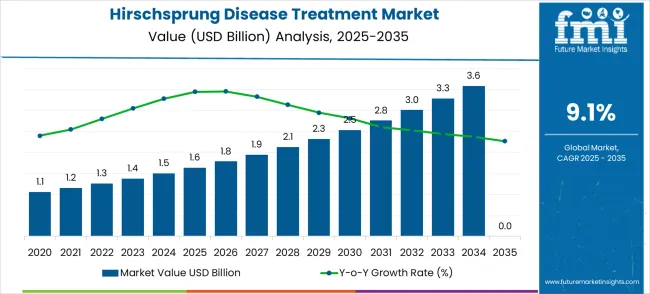
| Metric | Value |
|---|---|
| Hirschsprung Disease Treatment Market Estimated Value in (2025 E) | USD 1.6 billion |
| Hirschsprung Disease Treatment Market Forecast Value in (2035 F) | USD 3.9 billion |
| Forecast CAGR (2025 to 2035) | 9.1% |
The Hirschsprung Disease Treatment market is witnessing steady growth, driven by the increasing prevalence of congenital gastrointestinal disorders and the rising demand for effective therapeutic interventions. Awareness about early diagnosis and treatment of Hirschsprung disease has improved, prompting higher adoption of advanced drug therapies. The market is further supported by the development of specialized pharmaceutical formulations and targeted therapies that minimize complications and enhance patient outcomes.
Growing investments in pediatric healthcare infrastructure, coupled with enhanced hospital capabilities for surgical and post-operative management, are contributing to market expansion. The rising emphasis on patient-centered care, combined with regulatory initiatives promoting access to essential medications, is driving treatment adoption.
Moreover, advances in drug delivery systems and pharmacological research are enabling improved efficacy and safety profiles As healthcare systems prioritize early intervention and comprehensive disease management, the Hirschsprung Disease Treatment market is expected to sustain robust growth, supported by increasing clinical awareness, innovation in drug development, and accessibility through institutional healthcare channels.
The hirschsprung disease treatment market is segmented by drug class, distribution channel, and geographic regions. By drug class, hirschsprung disease treatment market is divided into Anti-Infective, Analgesics, and Antiemetic. In terms of distribution channel, hirschsprung disease treatment market is classified into Hospital Pharmacies, Drug Stores, Retail Pharmacies, and Mail Order Pharmacies. Regionally, the hirschsprung disease treatment industry is classified into North America, Latin America, Western Europe, Eastern Europe, Balkan & Baltic Countries, Russia & Belarus, Central Asia, East Asia, South Asia & Pacific, and the Middle East & Africa.
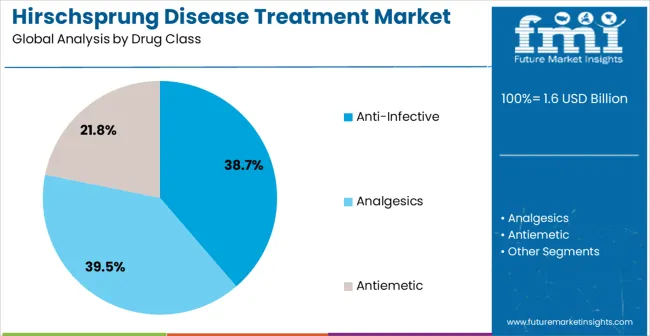
The anti-infective drug class segment is projected to hold 38.7% of the market revenue in 2025, establishing it as the leading drug class. Its dominance is being driven by the need to manage post-operative infections and prevent complications in patients undergoing surgical interventions for Hirschsprung disease. Anti-infective agents are essential in controlling bacterial overgrowth and reducing the risk of enterocolitis, which is a common comorbidity associated with the condition.
The efficacy, safety, and broad-spectrum activity of modern anti-infective formulations have reinforced their preference among healthcare providers. Ongoing research and development in antibiotic therapies, coupled with improved administration protocols, are supporting adoption.
Integration of these drugs into standardized treatment regimens ensures consistent patient outcomes and reduces hospitalization time As pediatric surgical interventions and post-operative care continue to increase, anti-infective therapies are expected to maintain their leading market position, driven by clinical effectiveness, guideline adherence, and the emphasis on minimizing treatment complications.
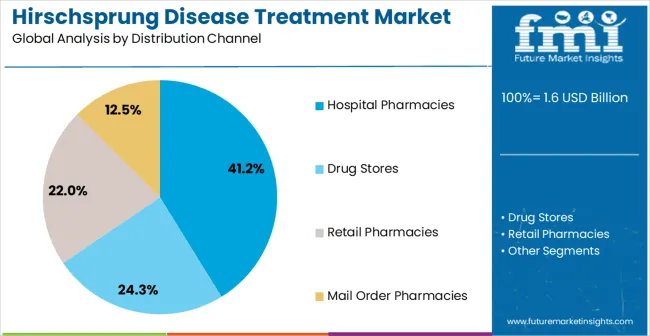
The hospital pharmacies distribution channel segment is expected to account for 41.2% of the market revenue in 2025, making it the leading channel for Hirschsprung disease treatments. Growth in this segment is being driven by the centralized procurement and dispensing of specialized medications within hospital settings, which ensures proper dosage, storage, and administration under professional supervision.
Hospital pharmacies play a critical role in supporting post-operative care, enabling timely access to anti-infective and supportive medications, and ensuring adherence to treatment protocols. Increasing hospital-based treatment of Hirschsprung disease, coupled with rising pediatric patient volumes, is further reinforcing reliance on institutional pharmacies.
The integration of hospital pharmacies with clinical workflows and electronic health records facilitates efficient management of patient prescriptions, inventory control, and regulatory compliance As healthcare providers continue to emphasize safe, monitored, and effective medication distribution, hospital pharmacies are expected to remain the dominant channel, supported by the growing number of pediatric hospitals, specialized surgical centers, and comprehensive care facilities worldwide.
Hirschsprung disease is a condition in which certain nerve fibers are absent in the segment of the bowel results in partial or full blockage of a stool which further leads to severe infection and damage to the colon. The condition is present at the newborn period and later in infancy and childhood as a result of missing nerve cells in the muscles of the baby's colon, and children are prone to a severe intestinal infection called enterocolitis which can be a life threatening.
Mortality from enterocolitis or surgical complications in infancy is 25-30%. Hirschsprung disease is a common cause of chronic constipation. Hirschsprung's disease is associated with certain inherited conditions, such as Down syndrome and other abnormalities present at birth, such as congenital heart disease.
Hirschsprung’s disease occurs once in every 5,000 live births and is about four times more common in males than females.Hirschsprung disease affects all races; however, it is roughly three times more common among Asian-Americans. The main signs and symptoms of Hirschsprung disease are constipation or intestinal obstruction, usually appearing shortly after birth.
Most often, an infant or a child with Hirschsprung disease will have other symptoms, including growth failure, swelling of the abdomen, unexplained fever, or vomiting. However, Hirschsprung disease can be treated, depending on the bowel condition and its severity and based on the patient's symptoms and medical history; this is expected to reflect positive growth in the global Hirschsprung disease treatmentmarket.
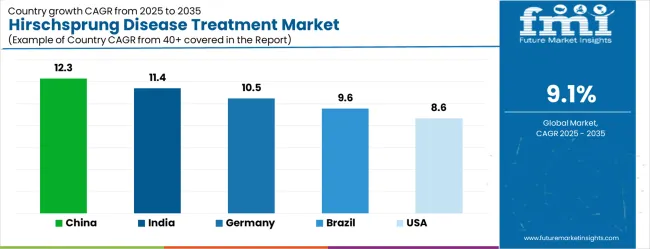
| Country | CAGR |
|---|---|
| China | 12.3% |
| India | 11.4% |
| Germany | 10.5% |
| Brazil | 9.6% |
| USA | 8.6% |
| UK | 7.7% |
| Japan | 6.8% |
The Hirschsprung Disease Treatment Market is expected to register a CAGR of 9.1% during the forecast period, exhibiting varied country level momentum. China leads with the highest CAGR of 12.3%, followed by India at 11.4%.
Developed markets such as Germany, France, and the UK continue to expand steadily, while the USA is likely to grow at consistent rates. Japan posts the lowest CAGR at 6.8%, yet still underscores a broadly positive trajectory for the global Hirschsprung Disease Treatment Market. In 2024, Germany held a dominant revenue in the Western Europe market and is expected to grow with a CAGR of 10.5%.
The USA Hirschsprung Disease Treatment Market is estimated to be valued at USD 610.1 million in 2025 and is anticipated to reach a valuation of USD 610.1 million by 2035. Sales are projected to rise at a CAGR of 0.0% over the forecast period between 2025 and 2035. While Japan and South Korea markets are estimated to be valued at USD 75.2 million and USD 40.9 million respectively in 2025.
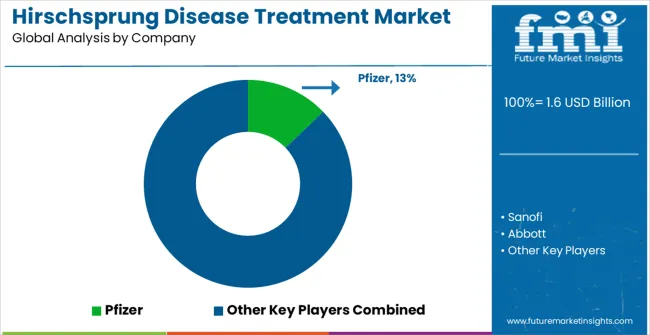
| Item | Value |
|---|---|
| Quantitative Units | USD 1.6 Billion |
| Drug Class | Anti-Infective, Analgesics, and Antiemetic |
| Distribution Channel | Hospital Pharmacies, Drug Stores, Retail Pharmacies, and Mail Order Pharmacies |
| Regions Covered | North America, Europe, Asia-Pacific, Latin America, Middle East & Africa |
| Country Covered | United States, Canada, Germany, France, United Kingdom, China, Japan, India, Brazil, South Africa |
| Key Companies Profiled | Pfizer, Sanofi, Abbott, Bayer Healthcare, Johnson and Johnson, Merck, Novartis, Bristol-Myers Squibb, Astellas Pharma, Cipla, AstraZeneca, GSK, Takeda Pharmaceutical, and AbbVie |
The global hirschsprung disease treatment market is estimated to be valued at USD 1.6 billion in 2025.
The market size for the hirschsprung disease treatment market is projected to reach USD 3.9 billion by 2035.
The hirschsprung disease treatment market is expected to grow at a 9.1% CAGR between 2025 and 2035.
The key product types in hirschsprung disease treatment market are anti-infective, analgesics and antiemetic.
In terms of distribution channel, hospital pharmacies segment to command 41.2% share in the hirschsprung disease treatment market in 2025.






Our Research Products

The "Full Research Suite" delivers actionable market intel, deep dives on markets or technologies, so clients act faster, cut risk, and unlock growth.

The Leaderboard benchmarks and ranks top vendors, classifying them as Established Leaders, Leading Challengers, or Disruptors & Challengers.

Locates where complements amplify value and substitutes erode it, forecasting net impact by horizon

We deliver granular, decision-grade intel: market sizing, 5-year forecasts, pricing, adoption, usage, revenue, and operational KPIs—plus competitor tracking, regulation, and value chains—across 60 countries broadly.

Spot the shifts before they hit your P&L. We track inflection points, adoption curves, pricing moves, and ecosystem plays to show where demand is heading, why it is changing, and what to do next across high-growth markets and disruptive tech

Real-time reads of user behavior. We track shifting priorities, perceptions of today’s and next-gen services, and provider experience, then pace how fast tech moves from trial to adoption, blending buyer, consumer, and channel inputs with social signals (#WhySwitch, #UX).

Partner with our analyst team to build a custom report designed around your business priorities. From analysing market trends to assessing competitors or crafting bespoke datasets, we tailor insights to your needs.
Supplier Intelligence
Discovery & Profiling
Capacity & Footprint
Performance & Risk
Compliance & Governance
Commercial Readiness
Who Supplies Whom
Scorecards & Shortlists
Playbooks & Docs
Category Intelligence
Definition & Scope
Demand & Use Cases
Cost Drivers
Market Structure
Supply Chain Map
Trade & Policy
Operating Norms
Deliverables
Buyer Intelligence
Account Basics
Spend & Scope
Procurement Model
Vendor Requirements
Terms & Policies
Entry Strategy
Pain Points & Triggers
Outputs
Pricing Analysis
Benchmarks
Trends
Should-Cost
Indexation
Landed Cost
Commercial Terms
Deliverables
Brand Analysis
Positioning & Value Prop
Share & Presence
Customer Evidence
Go-to-Market
Digital & Reputation
Compliance & Trust
KPIs & Gaps
Outputs
Full Research Suite comprises of:
Market outlook & trends analysis
Interviews & case studies
Strategic recommendations
Vendor profiles & capabilities analysis
5-year forecasts
8 regions and 60+ country-level data splits
Market segment data splits
12 months of continuous data updates
DELIVERED AS:
PDF EXCEL ONLINE
Airway Disease Treatment Market Size and Share Forecast Outlook 2025 to 2035
Zoonotic Disease Treatment Market Size and Share Forecast Outlook 2025 to 2035
Crohn’s Disease (CD) Treatment Market Analysis & Forecast by Drug Type, Distribution Channel and Region through 2035
Th17 Driven Disease Treatment Market
Communicable Diseases Treatment Market
Meningococcal Disease Treatment Market
Rare Neurological Disease Treatment Market Report – Demand, Growth & Industry Outlook 2025-2035
Rare Inflammatory Disease Treatment Market Size and Share Forecast Outlook 2025 to 2035
Industry Share Analysis for Rare Neurological Disease Treatment Providers
Interstitial Lung Disease Treatment Market
Inherited Retinal Diseases Treatment Market Size and Share Forecast Outlook 2025 to 2035
Swine Respiratory Diseases Treatment Market Analysis - Size and Share Forecast Outlook 2025 to 2035
Inflammatory Bowel Disease Treatment Market Size and Share Forecast Outlook 2025 to 2035
Neglected Tropical Disease Treatment Market Analysis - Size and Share Forecast Outlook 2025 to 2035
Chronic Respiratory Diseases Treatment Market
Hand, Foot and Mouth Disease Treatment Market
The Graft Versus Host Disease (GvHD) Treatment Market is segmented by Monoclonal antibodies, mTOR inhibitors, Tyrosine kinase inhibitors and Thalidomide from 2025 to 2035
Rare Gastrointestinal Diseases Treatment Market Trends and Forecast 2025 to 2035
Veterinary Respiratory Disease Treatment Market Size and Share Forecast Outlook 2025 to 2035
Vaginal and Vulval Inflammatory Diseases Treatment Market - Demand & Innovations 2025 to 2035

Thank you!
You will receive an email from our Business Development Manager. Please be sure to check your SPAM/JUNK folder too.
Chat With
MaRIA